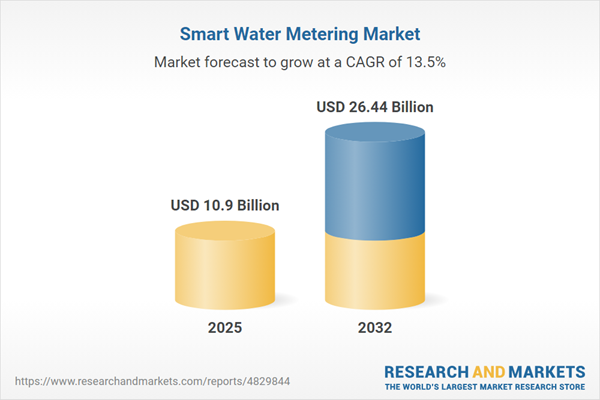Speak directly to the analyst to clarify any post sales queries you may have.
Senior executives across utilities are advancing digital transformation to drive operational efficiency, regulatory alignment, and infrastructure resilience. As organizations seek agile solutions, the smart water metering market stands out for enabling proactive risk management and next-level data insights indispensable for modern utility operations.
Smart Water Metering Market Snapshot
As of 2024, the smart water metering market is valued at USD 9.61 billion and projected to reach USD 10.90 billion by 2025, representing a CAGR of 13.48%. By 2032, the sector is forecasted to achieve USD 26.44 billion. This expansion is fueled by large-scale modernization programs and the rapid adoption of digital metering platforms, reflecting a drive for advanced resource management and better compliance outcomes. Transitioning to smart solutions, utilities are responding to regulatory shifts, deploying robust data-driven frameworks, and adopting network technologies that support operational resilience. Such advancements are strengthening competitiveness and supporting strategic upgrades within diverse regulatory landscapes.
Scope & Segmentation in the Smart Water Metering Market
- Component Types: Metering hardware delivers accurate water usage monitoring, while intelligent data management platforms provide actionable real-time analysis for performance optimization. Ancillary services such as consulting, installation, and ongoing maintenance enable utilities to achieve maximum value from smart water metering deployment and reduce operational risks.
- Technology Options: Advanced Metering Infrastructure (AMI) and Automated Meter Reading (AMR) improve utility efficiency through automated reporting and streamlined data collection, facilitating regulatory compliance for both simple and complex asset environments.
- Communication Technologies: Cellular, satellite, radio frequency, and power line communication systems support secure, uninterrupted data transmission. These technologies help organizations maintain oversight in both urban centers and remote service areas, ensuring operational stability regardless of deployment geography.
- Installation Types: Solutions include retrofit options for integrating with legacy systems and greenfield installations for new infrastructure. Phased rollouts align with utility investment strategies and reduce disruption while upgrading or expanding metering systems.
- End-User Segments: Municipal utilities, as well as residential, commercial, and industrial stakeholders, use smart metering analytics to improve resource transparency, enhance compliance, and develop informed strategies to meet regulatory mandates.
- Regional Coverage: The Americas, Europe, Middle East and Africa, and Asia-Pacific all represent significant markets. Regional adoption reflects local regulations, infrastructure readiness, and urbanization patterns. Notably, the United States, Germany, China, and India are accelerating implementations to address infrastructure needs and population growth.
- Industry Leaders: Major providers such as Itron, Xylem, Kamstrup, Diehl Metering, Badger Meter, Neptune Technology Group, Zenner, Arad Group, Honeywell International, and Schneider Electric drive innovation through interoperable technologies and strategic alliances, simplifying adoption across diverse markets.
Smart Water Metering Market: Key Takeaways for Senior Decision-Makers
- Digital water metering enhances transparency and supports regulatory compliance, easing the burden of audits and minimizing compliance risks for utility operators.
- Integrating advanced analytics allows utilities to identify inefficiencies and potential leaks earlier, improving preventative maintenance and lowering unplanned repair expenditures.
- Modular infrastructure promotes flexible integration with both existing and new systems, enabling targeted upgrades while managing financial and operational risks.
- Reliable communications infrastructure secures data visibility and maintains business continuity across multi-site operations.
- Customizable deployments allow organizations to balance investment priorities against operational continuity, reducing business disruption in transformation phases.
- Diversified sourcing and robust supplier relationships help utilities manage volatility in supply or technology, supporting risk mitigation in changing market conditions.
Tariff Impact: Navigating Cost and Supply Chain Pressures
U.S. tariffs on key smart water metering components are introducing procurement and supply chain challenges for utilities. In response, organizations are strengthening relationships with domestic vendors and strategically expanding their supplier bases. These adaptive approaches support operational stability and enable organizations to better address uncertainty and potential disruptions within the sector.
Methodology & Data Sources
This research draws from in-depth interviews with utility executives and industry analysts, complemented by a thorough review of sector publications, research studies, and regulatory documentation. Scenario-based forecasting ensures the delivery of actionable insights to guide strategic planning and effective risk management.
Why This Report Matters
- Provides senior leaders with a detailed framework for network modernization and regulatory adaptation, equipping them to align with evolving utility demands worldwide.
- Supports proactive planning for policy changes and infrastructure upgrades, empowering organizations to navigate dynamic environments with confidence.
- Offers direct guidance for supplier diversification and procurement strategy, strengthening risk management in the face of tariff-related headwinds.
Conclusion
These insights empower decision-makers to refine investment strategies, increase their organization’s adaptability, and sustain leadership through ongoing digital transformation in the utilities sector.
Additional Product Information:
- Purchase of this report includes 1 year online access with quarterly updates.
- This report can be updated on request. Please contact our Customer Experience team using the Ask a Question widget on our website.
Table of Contents
3. Executive Summary
4. Market Overview
7. Cumulative Impact of Artificial Intelligence 2025
Companies Mentioned
The companies profiled in this Smart Water Metering market report include:- Itron, Inc.
- Xylem Inc.
- Kamstrup A/S
- Diehl Metering GmbH
- Badger Meter, Inc.
- Neptune Technology Group, Inc.
- Zenner International GmbH & Co. KG
- Arad Group Ltd.
- Honeywell International Inc.
- Schneider Electric SE
Table Information
| Report Attribute | Details |
|---|---|
| No. of Pages | 192 |
| Published | October 2025 |
| Forecast Period | 2025 - 2032 |
| Estimated Market Value ( USD | $ 10.9 Billion |
| Forecasted Market Value ( USD | $ 26.44 Billion |
| Compound Annual Growth Rate | 13.4% |
| Regions Covered | Global |
| No. of Companies Mentioned | 11 |









